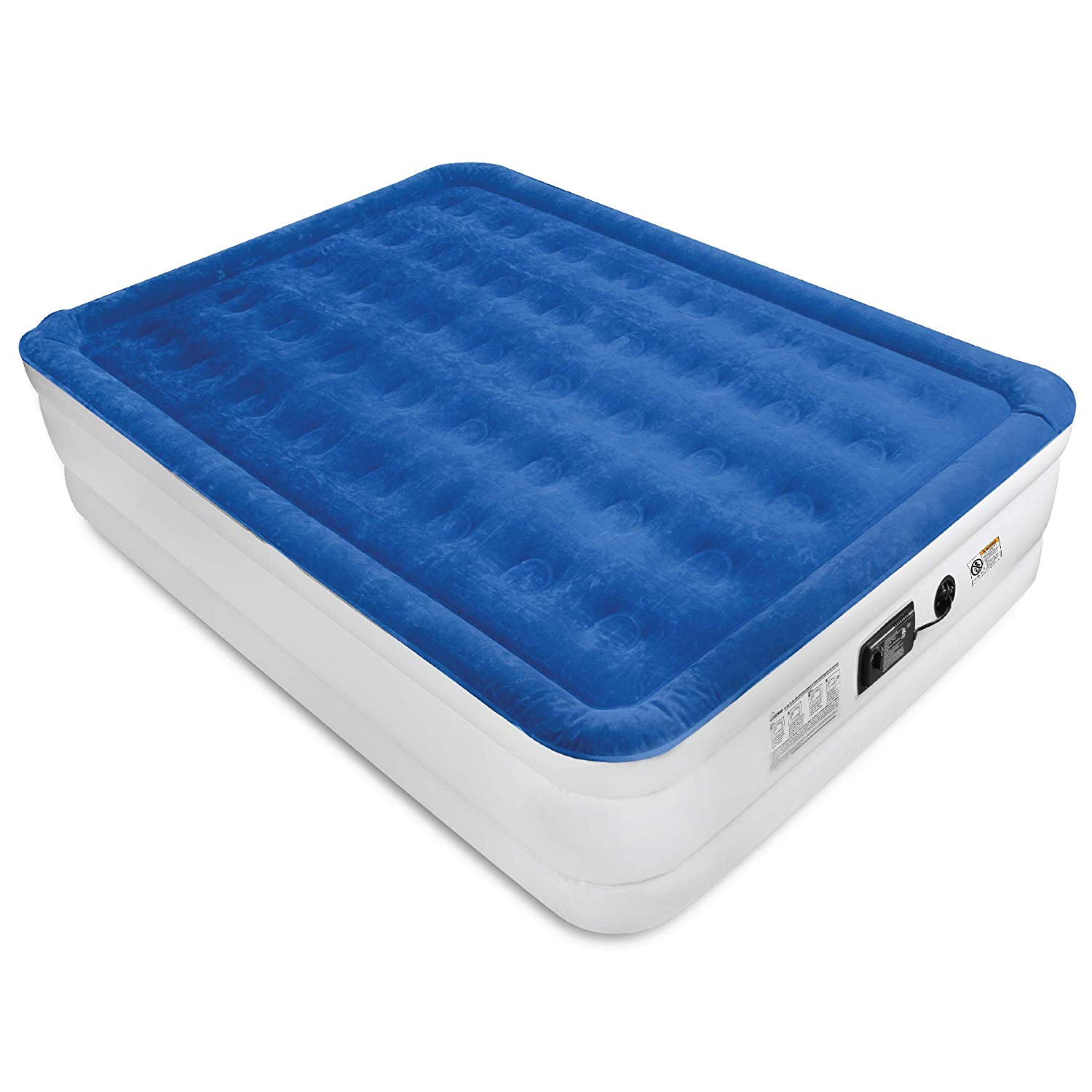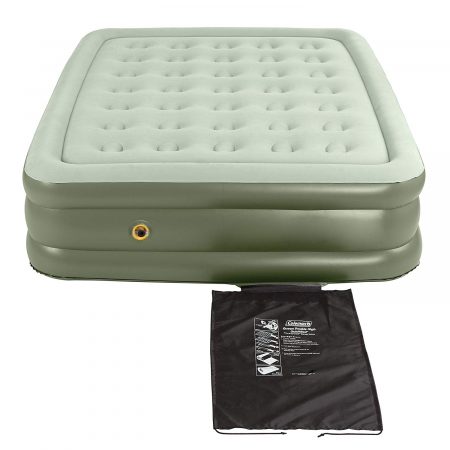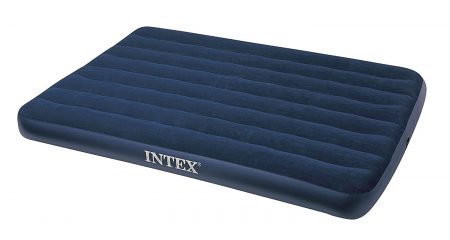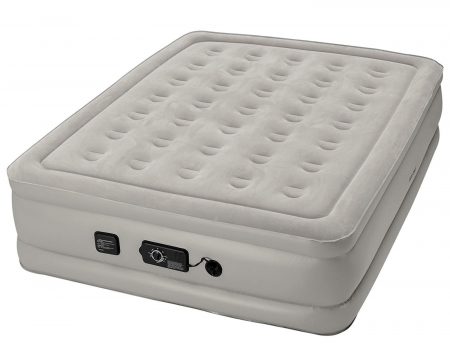Thickness
The majority of temporary air mattresses sold today are raised elevation (or ‘double high’) models that measure more than 10 inches thick, and many mattress models are 20 or more inches thick. These mattresses may take longer to inflate (especially with manual inflation), but getting on and off of these models is relatively easy.
Select air mattresses fall in the standard elevation (or ‘single high’) category, meaning they are 10 inches thick or shorter; the majority fall between eight and 10 inches. Some of these models are designed for children, but there are also standard elevation options for adults. However, getting on and off of a standard elevation air mattress can be fairly difficult.
Air Mattress Materials
When shopping for an air mattress, another key consideration is the material(s) used in construction. Most temporary air mattresses are made using polyvinyl chloride, or PVC, a synthetic plastic polymer. PVC is used to produce a wide range of goods.
However, the material has raised numerous environmental and human health concerns over the years. The use of chlorine in the PVC production process is among these concerns. Some mattresses are made with ‘eco-friendly PVC,’ which refers to PVC that is non-chlorinated. Despite the absence of chlorine, there are additional environmental and health concerns with ‘eco-friendly’ PVC.
As an alternative to PVC, some temporary air mattresses are made from textile-backed plastics or rubber components. One example of an alternative to PVC mattress material is known as Thermoplastic Polyurethane (TPU). An elastic, biodegradable substance that doesn’t require a toxic chemical treatment, TPU is considered an eco-friendly, healthy alternative to PVC mattresses.
But air, plastic, and rubber components aren’t the only materials you’ll find in air mattresses. In addition to the air chambers, some air mattresses are designed with microcoils in the uppermost area for added comfort and pressure relief.
Also on the market are air mattresses with memory foam toppers. Airbeds with memory foam upper layers are designed to offer additional comfort and contouring. While heavier, memory foam models generally can be rolled up easily into a carrying case.
Air Mattress Pumps
As the names implies, external pumps attach to a nozzle on the outside of the mattress. External pumps may be operated manually (typically using a foot pedal), or powered using batteries or an electrical system. Manual external pumps can be time- and energy-consuming to operate. By comparison, electrical pumps are much faster and ideal in the event you have to wake up in the night to quickly re-inflate a mattress.
The main downside of external pumps is they often have to be purchased separately from your air mattress, which can set you back anywhere from $10 to $30. Another drawback of using an external pump is the risk of losing it.To avoid misplacing your external pump, always store the mattress and the pump together.
Internal Pumps
Internal pumps are built into the air mattress. Most internal pumps are operated using knobs or buttons. These pumps have the advantage of containing no spare, extraneous parts, which can be lost easily. They also tend to inflate at a much quicker rate, since they use batteries or electrical mains and are never battery-operated. Two notable downsides: internal pump air mattresses are typically more expensive than external pump models, and are also more prone to equipment breakdowns that affect the owner’s ability to inflate the mattress.
Price and Warranty
A new temporary air mattress usually won’t break the bank. Most models are priced at $150 or lower. On the lower end of the pricing spectrum are air mattresses made of PVC without internal pumps. On the higher end are TPU air mattresses and air mattresses with special features like internal pumps, microcoils, and memory foam toppers.
An air mattress may come with a warranty, but most do not extend beyond one year of coverage. Other models do not come with any sort of warranty. Generally, filing warranty claims for any type of mattress can be a hassle, as well as costly. Owners may be responsible for charges associated with transporting defective mattresses, and these costs may be on par with the price of a new air mattress model.
Other Buying Considerations
In addition to crucial considerations like size, material, and price, there are a number of other factors to look at before investing in an air mattress:
Weight Capacity: Most air mattresses can support at least 300 pounds, which is adequate for the vast majority of sleepers, as well as sleeping bags, pillows, blankets, and other bedding accessories. However, customers should inquire about the weight capacity of different models.
Mattress Weight: When fully deflated, most temporary air mattresses weigh 20 pounds or less. Customers looking for a backpacking air mattress may prefer models that are on the lighter side (between 8 to 10 pounds when deflated).
Noise: Air mattresses with internal or external pumps that are battery- or electricity-powered tend to produce a fair amount of noise during the inflation process, but most are relatively quiet during the night. However, regardless of the pump, many owners claim that the mattress produces squeaking sounds whenever they shift positions. A mattress topper or pad may reduce the noise potential to some extent.
Durability: Most temporary air mattresses have limited durability. However, reserving these mattresses for occasional use and storing them properly can significantly extend their lifespan. See the maintenance tips section below for more information.
Air retention: Air retention is particularly important when choosing an air mattress model. A mattress that deflates quickly and easily will not provide adequate support, leading to aches, pains, and disrupted sleep. Air retention is particularly important in colder climates, when air becomes condensed and air mattresses may lose their shape and comfort. One study found that sleeping on air mattresses in cold climates resulted in less comfortable, less restful sleep.
To identify an air mattress with superior air retention, examine customer reviews and the warranty. A quality mattress that offers good air retention should offer a two- or three-year warranty against manufacturer defects.
Maintenance Tips
Properly maintaining an air mattress can greatly extend the product’s lifespan and help ensure optimal performance for each use. This section will look at tips for storing mattresses, keeping the mattress inflated, and repairing air leaks.
Storage
Air mattresses should be kept in spaces that are not too hot or cold. Additionally, the storage space should not be too humid or susceptible to moisture buildup. Be sure to check the area for sharp objects that could potentially cause punctures and other types of physical damage to the mattress. Also make sure the mattress is placed in a position where pets with claws will not be able to come into contact with it.
A large number of air mattresses come with duffle bags, carrying cases, and other storage units. These provide an extra layer of protection, and also make the mattress more compact and portable.
Keeping the Mattress Inflated
Most air mattresses require some level of inflation each time they are used. Although they are designed for customizable inflation/deflation settings, owners should never over-inflate the mattress. This can lead to tears and rips that cause air leakage.
Some manufacturers recommend inflating and deflating the mattress at least once prior to using it. This will help break in the mattress.
Repairing Air Leaks
A vinyl leak repair or patching kit may be a smart investment for air mattress owners. These kits are often sold with the mattresses themselves. They are commonly found in outdoor and sporting goods stores.
The leak repair process for air mattresses is as follows:
- 1. Identify the source of the leak by listening for hissing sounds.
- 2. Once a leak has been identified, completely deflate the mattress and let it rest for a few minutes to ensure all of the air has been removed.
- 3. Administer sealant from the repair kit and allow it to set for several minutes.
- 4. Apply at least one more layer of sealant. There is no such thing as too much sealant, though two to three layers should do the trick.
- 5. Place a patch over the sealed area for added protection.
Under no circumstances should the air mattress be placed in water to help pinpoint the location of the leak (as one might do with other leaking items, such as bicycle tires). This can cause irreparable damage to the interior of the mattress.
For more information, please visit our guide to repairing leaks in temporary air mattresses.



